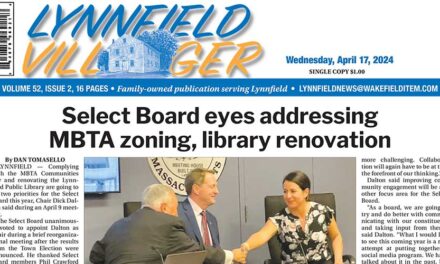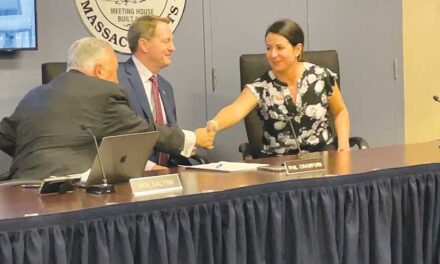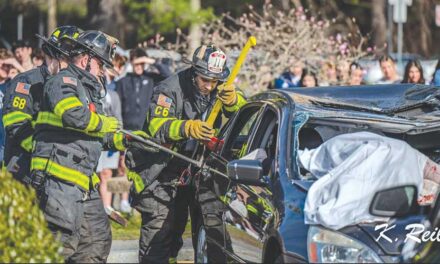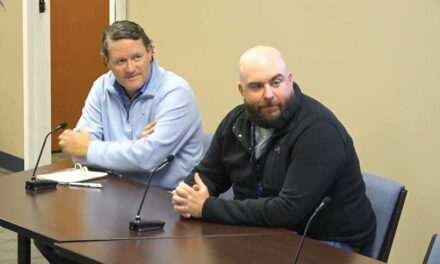Published May 12, 2021
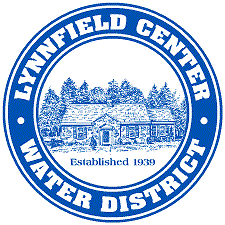
By DAN TOMASELLO
LYNNFIELD — Lynnfield Center Water District (LCWD) ratepayers overwhelmingly approved the $9.8 million capital improvement project during the Annual District Meeting on Monday night.
LCWD Superintendent John Scenna gave an overview of Article 18, which asked ratepayers to approve appropriating $9.8 million for two different capital projects in order to address the district’s water quality and quantity issues.
Scenna said the projects entail constructing a $6.3 million greensand filter water treatment plant at the Glen Drive station in order to treat iron and manganese that has caused discolored water issues that have impacted a number of ratepayers. He also said Article 18 sought to address the district’s water quantity issues by getting supplemental water from the Massachusetts Water Resource Authority (MWRA) via Wakefield.
The superintendent recalled that LCWD officials have been studying the two different issues for over 15 months.
“Since the beginning of our work, we assembled the most qualified team of engineers to look at and examine all options,” said Scenna. “The district requires sufficient maximum capacity, consistent water quality and adequate fire suppression. All of these are contested at times today. The proposal to connect to the Wakefield system, become members of the MWRA and upgrading the Glen Drive station maximizes the existing strengths of the LCWD system.”
CDM Smith project engineer Mike Nelson discussed how the LCWD’s existing groundwater would be blended with surface water from the MWRA. After the LCWD went into a Level 5 water emergency last summer, Nelson said the Massachusetts Department of Environmental Protection required CDM Smith to undertake a “blending analysis” in the event the LCWD had to connect with the Lynnfield Water District on an emergency basis.
“We had to make sure the water was safe for firefighting and domestic use,” said Nelson. “We had to do a blending analysis because the MWRA uses chloramines and the district uses chlorine. It is a common practice for smaller water districts to blend water with the MWRA. Needham, Wakefield and Woburn do this every day. It is safe. We did that study, and the DEP approved it. There were no significant problems.”
LCWD Clerk Tim Doyle read a statement from Fire Chief/Emergency Management Director Glenn Davis that expressed his support for the supplemental water pact with Wakefield because it will improve fire suppression in town.
“The ability to now rely on an MWRA source as needed, in periods when demand on the system exceeds supply, is imperative, is timely and is fully supported by our Fire Department,” Davis wrote. “The town of Lynnfield continues to see new growth, continues to see higher demand from existing users and yearly weather pattern challenges continue to present operational challenges to groundwater sources. The project will help sustain pressures throughout our entire fire suppression system in periods of high demand.”
Townsend Road resident Michael Walsh said he opposed the capital project because of its price tag. He said CDM Smith should have looked at alternative water sources such as the Saugus River watershed, Hawkes Pond and Suntaug Lake instead of the MWRA.
“Why aren’t we using the surface waters here in Lynnfield to provide water for residents?” asked Walsh. “I really do wish that the projects were parceled out because the voters want to control what their future looks like. This is an awfully big bill. I don’t think we looked at all of the options.”
Patrice Lane Pat Campbell said she supported the greensand filter project because it would treat iron and manganese similar to an existing plant at the Phillips Road station.
“If we build a greensand filter plant at Glen Drive, the quality of the water will be improved,” said Campbell. “If we don’t, many of us will have brown water because 40 percent of the water comes from Glen Drive and circulates throughout the LCWD. It’s expensive, but essential.”
A woman in the audience experienced concerns about mixing MWRA water and LCWD water. She claimed that a CDC representative and public health organizations told her it was not safe to combine chlorine and chloramine.
Nelson said the DEP and the Environmental Protection Agency are both in charge of regulating drinking water supplies and said the CDC does not have that authority.
“The DEP and EPA both approved the blending analysis study and they approved the other communities whose water sources get blended,” said Nelson.
Bourque Road resident Alan Dresios made a motion that sought to remove the MWRA supplemental water project from Article 18 by reducing the borrowing amount from $9.8 million to $6.3 million.
“I think we need to do a better job writing these articles,” said Dresios. “Everybody here supports the greensand filter project. The sticking point is the MWRA connection. It looks like somebody is trying to slide something under the carpet here.”
Water Commissioner Jack Adelson was infuriated by Dresios’ accusation.
“Nobody is trying to deceive anybody,” said Adelson. “We are dealing with two groups in town. Some groups are dealing with dirty water and other groups have low water pressure where they can’t flush toilets or take showers. The fire chief has been worried about being able to put out a fire. It’s a package put together to protect and enhance all of the customers in this district. It works as a unit.”
After the discussion, the Annual District Meeting voted to reject Dresios’ motion.
Ratepayers subsequently approved Article 18 by a 96-17 vote.
Wakefield pact OK’d
The Annual District Meeting’s attendees engaged in a brief discussion about Article 19, which asked ratepayers to authorize the LCWD to enter into a 20-year inter-municipal agreement with Wakefield.
Campbell urged ratepayers to vote against Article 19 because she opposed having the LCWD get supplemental water from the MWRA and Wakefield.
“The MWRA is an above ground water source,” said Campbell. “It is more vulnerable to contamination along the way, terrorism and computer breaches compared to the LCWD. In this day and age, I would much rather depend on an underground system rather than a huge one.”
Campbell also expressed concerns about Wakefield’s other water source, Crystal Lake, being located near a business district.
Maiden Lane resident Leon Glicksman urged ratepayers to approve Article 19.
“I have lived in Lynnfield for 48 years and I have attended LCWD meetings during that time,” said Glicksman. “We have constantly had problems with our water supply here. The water supply is very limited in this area, and we know that the amount of water we can take out from the Ipswich River watershed is limited. Connecting to the MWRA makes sense because it gives us security.”
After the discussion, ratepayers approved Article 19 on a voice vote.
LCWD officials pleased
LCWD Board of Water Commissioners Chairman Joseph T. Maney was pleased ratepayers approved the $9.8 million capital project.
“It is great for the district,” said Maney. “I have always said from day one that we need to solve the two problems that plague this district, and I am glad the ratepayers stepped up and did that tonight.”
Scenna agreed.
“I am happy that the ratepayers supported the Board of Commissioners and their vision for the projects that solve all of our issues,” said Scenna. “We are looking forward to moving forward to design and construction, and we will be continuing to work on the district’s behalf.”
LCWD officials anticipate the projects will result in an average water bill increase of $200. The projects are slated to be completed by 2023.

